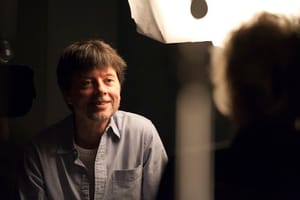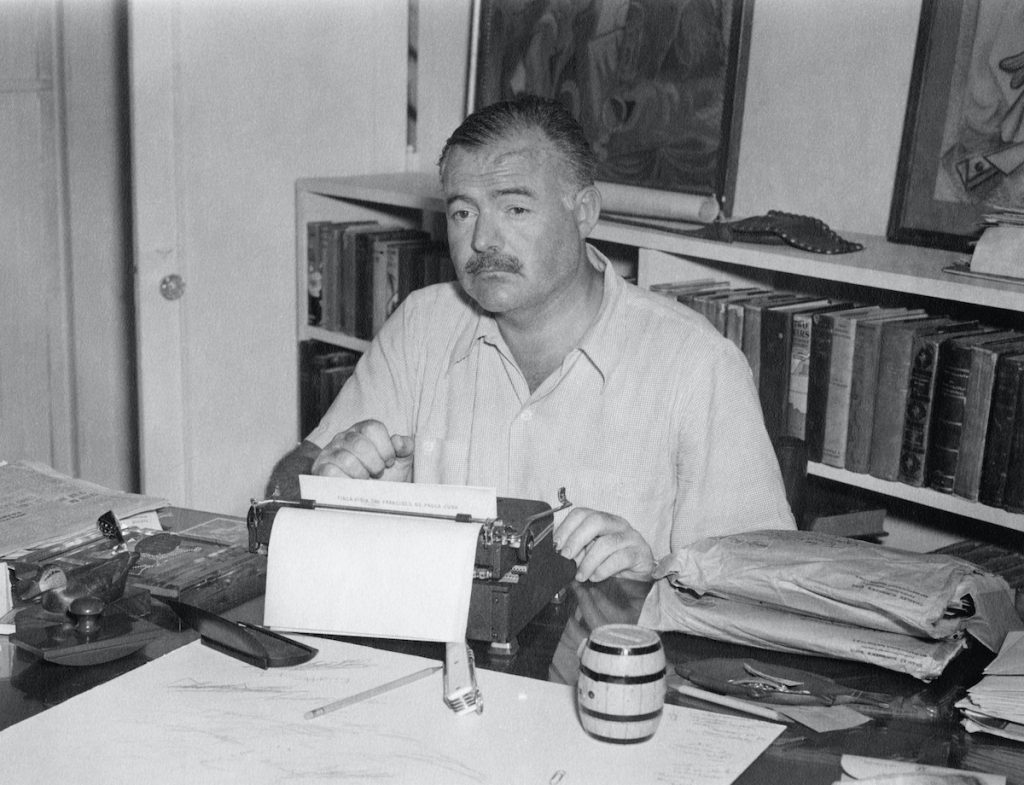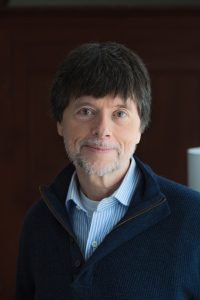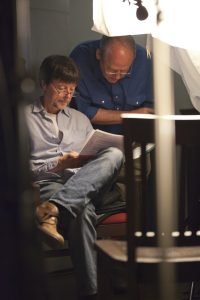
This fall marks the 40th anniversary of Ken Burns’ first documentary, Brooklyn Bridge. In the decades since, he’s established himself as our foremost chronicler of American history on film, with often-lengthy documentaries including Baseball, Jazz, The Civil War, The Vietnam War and Jackie Robinson. His new three-part, six-hour series on Ernest Hemingway, directed with his longtime collaborator Lynn Novick, hits PBS this spring, followed by Muhammad Ali later this year.
He has spent his entire professional career in New Hampshire, and maintains an envious partnership with PBS which allots him the time and space to do as much work as he and his tight-knit team feel is necessary on projects they carefully select and map out years in advance.
While his iconic moviemaking style is often imitated, there is no true formula for a Burns film. He tells MovieMaker that he and his team deliberate over every decision, and that he agonizes over them all. An upcoming series on the American Revolution is slated for 2025, and it’s already causing him sleepless nights.
Ken Burns hasn’t forgotten the lessons or the funding rejections of his earliest film, either, and here he shares some of the wisdom that has allowed him to thrive as one of Hollywood’s preeminent outsiders. —C.H.
As told to Caleb Hammond

1. I would be the master of dishonesty if I didn’t say that two supremely frustrating clichés actually are the most important advice I could give. One is to know who you are, that is to say, to make sure this professional life in filmmaking is what you’re supposed to be doing. There’s no shame in saying, “You know what? I don’t have something to say.” So there’s a kind of Socratic, inner, “Who am I?” And then there’s perseverance. There are lots of people a lot smarter and more talented than me, but some of them didn’t have the same perseverance. I used to keep on my desk two three-ring binders, each about three inches wide, that had all the rejection letters that I got trying to get funding for my first film, Brooklyn Bridge. It has nothing to do with talent. It had to do with perseverance.
2. The only rule is: What works, works. And a corollary of that is one from the editing room: A shot lasts as long as it lasts. That’s it.
3. A film is at least a million — no exaggeration, no hyperbole — at least a million problems. The wonderful thing about this process is that you needn’t see the word “problem” as pejorative, but just the inevitable lawful friction of trying to get something done in the universe, in this art form that we call film. It is the joy at finding solutions. Sometimes the problem eats you, sometimes you eat the problem, sometimes it’s a standoff, but that’s what all of these films are, whether they are experimental, dramatic, documentary.
4. After all of these years, more than 40, I find that the sense of film as architecture is wrong. You’re not building something, you’re actually subtracting. It’s not additive, it’s subtractive. You get a lot of material, and then you pull it away. That’s obvious. But we too often think of ourselves as architects.
5. I conducted my first on-camera interview in January of 1972, with a blimped Arriflex 16BL camera. It was so expensive. It was so terrifying. I was a student and I am still a student. I still approach an interview with the same humility and sense of lack of arrogance that I had back then. I don’t try to recreate that, it is automatically recreated in me. And so, if I don’t get much out of that interview, it’s my fault. If I get a lot out of the interview, it’s their greatness. That’s the way it is.
The most important thing is to listen. In my field of documentary, we come with written questions. And I have seen too often that there is a tyranny of those questions over the time allotted. Intense, almost exaggerated listening is what I do. If you’re interviewing a veteran of the Second World War (as I have), that twitch means that question 14 that you’re on has a 14A, B, C, D, E, F, G — that’s where you’re going to stop. And if it takes three rolls of 16mm film just to pursue that, or however long of the digital ones and zeros, do it.
6. There’s no such thing as analog or digital research — there’s just research. Today is it predominantly digital? Probably. But there’s nothing outside of COVID-19 that prevents you from going to a place and discovering things that are simply offline.
When you’re in an archive, you have the ability to say, “Whoa, what’s that up on the wall?” in the director or the curator’s office. Or, “Do you have anything else that nobody’s asked for?” “What’s the favorite thing that you have in your collection that no one’s come to talk about?” Inevitably, you find unbelievable things that you don’t find in a digital search. Now COVID makes a lot of that moot, at least for the time being. But the point is too often, you’ve got a set research period: OK, we’re going to research for three months, we’re going to write for three months, the script we produce is basically, if not written in stone, just informing the shooting and the editing. But as I’ve said, we never stop researching.

7. No hero is perfect. No villain is perfectly evil. We live in a binary world that suggests that that’s true. Everything is down to ones and zeros. Everything is good or bad, male or female, rich or poor, black or white, young or old, gay or straight, red state or blue state. And it’s not like that. And there are other periods in American history where it’s been like this. “There’s nothing new under the sun,” as the Bible says.
I have a neon sign in our editing suite that says in cursive, “It’s complicated.” That’s a reminder that too often, we settle as people, as filmmakers, as artists, for something that’s seemingly working, when the better thing is the deeper thing, the more complicated thing, that that surf there that seems so calm holds deadly riptides or undertow. That seemingly shallow thing is profoundly deep. We’ll leave it to the tabloids to tsk tsk or shame, or the Internet. We’re interested in deep dives.
Also read: Quentin Tarantino: Things I’ve Learned as a Moviemaker
Hemingway has monstrous aspects to him. He’s also one of the greatest writers ever. Somewhere in the tension of that is something that you want to get at that’s true and complicated. This is the kind of thing that we extend to the people that we love. And yet, we don’t do it out in the world. We’re so quick to make a judgement of good or bad, a thumbs up or a thumbs down. The anonymity of the internet has become a toxic cesspool, which is why I don’t participate. I’m not on Facebook, I have somebody who periodically tweets for me. I don’t need to have my life distracted by bile. There’s enough in our own lives.
8. The idea of filmmaking has become, at the end, something like the Emerald City as Hollywood, and they call it The Industry. That ought to be the warning light right then and there. Now, are there people who negotiate that industry with even more intelligence and independence than I have in my professional arena? Absolutely. And great cinema has been made from it — really, really great films have been produced. But a lot of it is just industry. They put silhouetted palm trees on their stationery, but it ought to be smoke stacks. That’s why I’m with public broadcasting, which has one foot tentatively in the marketplace and the other proudly out, and why I live in rural New Hampshire. My neighbors care about whether I’m a good citizen, not whether I’m a boldface name or not.
9. Any decision about a changing of a “the” to an “a” in the script, or any change of a shot in the film, I’m always there.
10. Every painter has lots of possibilities. Every musician has this paper with a score on it. And how you use the many techniques, over time and authentically, organically — that is to say, to who you are — then you have a style. But having said that, you can sit in the middle of a gallery in Paris of Impressionists, and there’s a whole bunch of Cézannes. If you sit in the middle, they all look alike. They have a distinctive style, you might say. But if you go up to them, they’re all different. Whatever that style is is merely the authentic application of techniques.

At a distance from all the films, they look like this. “Oh, that’s a Ken Burns film. I know what that means.” There is not a film even remotely similar to one another in how they’ve been accomplished. Everything is calibrated and recalibrated. Some films are mostly narration with very few first- person voices, or lots of narration and talking heads, or very few talking heads and many, many voices and less narration. Some films have been only first-person voices and talking heads and title cards replacing narration. Other films have a plethora of still photographs. Other films are about periods where there are no still photographs, so it’s all live cinematography, like Thomas Jefferson.
The thing that is recognizable is the fact they are each united by a common factor, which is me, and that I’m not doing it in any false way. I’m really struggling, and no film has a formula. I agonize over it. It’s why a three-part series on Ernest Hemingway took six-and-a-half years. It’s why I’m working on a history of the American Revolution that we want to finish in 2025, a year before the 250th anniversary, and I wake up at three in the morning with a knot in my stomach, because that feels like tomorrow. Because our process demands that we question absolutely everything.
11. Be so super careful not to believe your own PR, or not to create a PR myth that you can’t handle. In many ways, that’s what did Hemingway in. Obviously, there were extenuating, genetic and circumstantial things. But, everybody makes the fish bigger the farther away from the lake you get. It’s just what human beings do. You just have to be careful to make sure that your own art and your own intimate relationships are free of mythology about yourself.
12. The people who are the cinema trivia experts, who have seen everything and can press the buzzer and win Jeopardy, are great — but they sometimes miss the forest for the trees. If you aren’t getting influenced from everywhere, from nature, from, if you’re of that type, faith. Faith has lots of different contexts. We have faith in process, for example, and the opposite of faith in process is not doubt. Doubt is the engine of faith. The opposite of faith is certainty. “Oh, this is right.” “This scene works, we’re leaving.” And that means no complicating material can come into it, because the scene “already works,” and that’s all that matters, which is a dead end. So you need to draw from literature, from
art, from nature, from other people, from observation, from religion — if that’s your thing.

13. In music, it’s not the notes, it’s the intervals between them. In film, it’s not the actual shot, it’s the cut between the two shots.
14. I have lots of friends who went to Hollywood to make it and they gave themselves five years. And if they didn’t, they were going to come back. And they didn’t make it in five years, and they didn’t make it in 10. They’re scuffling around and the best they could do was an afterschool special when they wanted to be Howard Hawks, or John Ford, or Alfred Hitchcock, or Sir Carol Reed. There’s a kind of prison to not being able to say, I want to do this, I can only do this my way. That’s why I made the decision long ago to move to New Hampshire. People said, “You’re moving to New Hampshire? Are you out of your mind?”
I knew that if I could move someplace where I didn’t have that pressure, I wouldn’t put those rolls of film up on top of the refrigerator and wake up 25 years later, having not done that film, but made a good living. A lot of those people were looking for the payday and a lot of people that I know, that didn’t get stuck, they got their five-year plan, they made an industrial film that was popular in Hollywood, and then they were trapped. They couldn’t not do that. There was a nut they had to have. They had to live in a certain neighborhood that meant a certain house, and that meant a certain mortgage, and they need a certain car, and then all of a sudden, who’s driving who?
Hemingway, directed by Ken Burns and Lynn Novick, premieres on PBS tonight.
